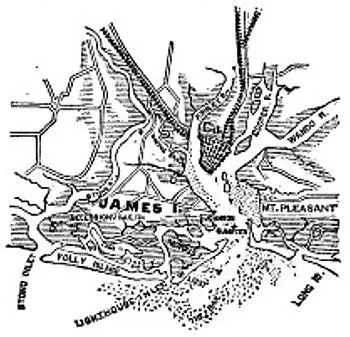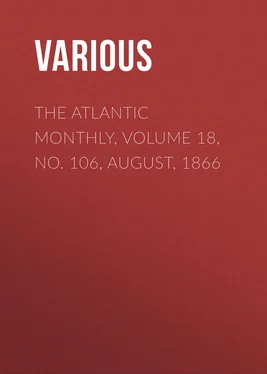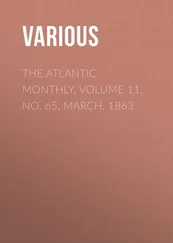Various - The Atlantic Monthly, Volume 18, No. 106, August, 1866
Здесь есть возможность читать онлайн «Various - The Atlantic Monthly, Volume 18, No. 106, August, 1866» — ознакомительный отрывок электронной книги совершенно бесплатно, а после прочтения отрывка купить полную версию. В некоторых случаях можно слушать аудио, скачать через торрент в формате fb2 и присутствует краткое содержание. Жанр: foreign_antique, periodic, foreign_edu, на английском языке. Описание произведения, (предисловие) а так же отзывы посетителей доступны на портале библиотеки ЛибКат.
- Название:The Atlantic Monthly, Volume 18, No. 106, August, 1866
- Автор:
- Жанр:
- Год:неизвестен
- ISBN:нет данных
- Рейтинг книги:3 / 5. Голосов: 1
-
Избранное:Добавить в избранное
- Отзывы:
-
Ваша оценка:
- 60
- 1
- 2
- 3
- 4
- 5
The Atlantic Monthly, Volume 18, No. 106, August, 1866: краткое содержание, описание и аннотация
Предлагаем к чтению аннотацию, описание, краткое содержание или предисловие (зависит от того, что написал сам автор книги «The Atlantic Monthly, Volume 18, No. 106, August, 1866»). Если вы не нашли необходимую информацию о книге — напишите в комментариях, мы постараемся отыскать её.
The Atlantic Monthly, Volume 18, No. 106, August, 1866 — читать онлайн ознакомительный отрывок
Ниже представлен текст книги, разбитый по страницам. Система сохранения места последней прочитанной страницы, позволяет с удобством читать онлайн бесплатно книгу «The Atlantic Monthly, Volume 18, No. 106, August, 1866», без необходимости каждый раз заново искать на чём Вы остановились. Поставьте закладку, и сможете в любой момент перейти на страницу, на которой закончили чтение.
Интервал:
Закладка:

Fig. 2. Map of Charleston and Vicinity.
Charleston stands upon the extremity of a narrow peninsula, between the Cooper and the Ashley Rivers. Charleston Harbor, supplied by these and some smaller streams, lies between Mt. Pleasant and Sullivan's Island on the northeast, and James and Morris Islands on the southwest. One cannot but be struck with the resemblance, so great as to be almost symmetrical, between the two sides of the harbor. Mt. Pleasant and James Island are quite high land,—high at least for the coast of South Carolina,—and are separated from the mainland, the one by the Wando River, the other by Wappoo Creek; while Sullivan's Island, where stand Fort Moultrie and other Rebel batteries, corresponds almost precisely to Morris Island, both being low and sandy, and being, as it were, bent inland from the sea, with sharp points looking toward the city, their convex shores forming a rounded entrance to the harbor. Extending southward from Morris Island, and separated from it by Lighthouse Inlet, is Folly Island; and in exact correspondence to the latter, north of Sullivan's Island, and separated from it by Breach Inlet, is a similar sand-ridge called Long Island. But now occurs a difference; for while between Long and Sullivan's Islands and Christ's Church Parish is an immense salt marsh intersected by creeks, but presenting an unbroken surface, in the midst of the corresponding marsh between Morris and Folly Islands and James Island is a group of low wooded islands, the largest of which lies opposite the upper or north end of Folly Island. To this no name is given on the maps, nor is it even distinguished from the marsh. It is, however, completely surrounded by water; and, though this is in the form of creeks neither wide nor deep, yet the peculiar softness of the mud, and the absence of any landing-place except upon the side toward Folly Island, render it almost inaccessible.
To this narrow strip of land, not three miles in length, was given the name of Long Island,—perhaps by our own troops, who knew nothing of an island of the same name north of the harbor; and in case it is found that no other name belongs to it, we may properly avoid a confusion, and christen it Spider Island, in honor of the remarkable insects for whose especial benefit it seems to have been made, and which, with the exception of the mosquitoes, are its sole inhabitants.
As was said, the first spider was found on Folly Island on the 19th of August, 1863: it was also the last there seen. During the summer of 1864, many were found on Long Island (so called); and when, in the spring of 1865, our regiment was encamped on James Island near Wappoo Creek, it was toward Long Island that all my attention, so far as concerned spiders, was directed.
But first, as a bit of collateral history, and to show how easily and how far one may go astray when one of the links in the chain of argument is only an inference , let me relate that, while riding over James Island, I observed upon trees and bushes numbers of small brown bags, from half an inch to an inch and a half in diameter, pear-shaped, and suspended by strong silken cords. The bags themselves were made of a finer silk so closely woven as to resemble brown paper, and, when opened, were found to contain a mass of loose silk filled with young spiders to the number of five hundred or more. In certain localities, especially in a swampy field just outside the first line of Rebel works, they were quite abundant. I had soon collected about four hundred of them, which, by a moderate estimate, contained two hundred thousand little spiders ,—quite enough, I thought, with which to commence operations. But one hot day in June I placed them all on a tray in the sun. I was called away, and on my return found my one fifth of a million young spiders dead,—baked to death.
Prior to this catastrophe, however, I had become convinced that these were not the spiders I sought. Indeed, my only reasons for thinking they might be were, first, the abundance of these cocoons in a locality so near Long Island; and, second, my own great desire that they should prove the spiders I wanted. The young spiders, it is true, did not at all resemble their supposed progenitors, as to either shape, or color, or markings; yet all of these evidently changed during growth, and would not of themselves disprove the relationship.
One day in April, however, a cocoon was found in a tree on James Island, of a very different appearance from the others. It was of loose texture, and, instead of being pear-shaped, was hemispherical in form, and attached by its flat surface to the lower side of a leaf. This also contained young spiders, a little larger and a little brighter in color than the others, but really bearing no resemblance to the full-grown spiders of Long Island. This single cocoon formed the entering wedge of doubt, and soon it was clear that the only means of proof lay on Long Island itself.
But how was this to be reached? Easily enough while we were upon Folly Island and could row through the creeks to a wharf on the east side of Long Island. But now the case was altered; for between James and Long Islands was the immense marsh already mentioned, intersected by creeks, and composed of mud practically without bottom, and ranging from eighteen to twenty-three feet in depth by actual measurement. Around or over or through this marsh it was necessary to go, in order to reach Long Island, the home of the spiders.
I could easily occupy the rest of my allotted space in recounting my various attempts to reach this El Dorado, which my fancy, excited by every delay, stocked with innumerable cocoons of the kind already found so abundantly on James Island. These I expected would furnish thousands of spiders, the care of which, with the reeling of their silk, would give employment to all the freed people in South Carolina,—for even then the poor creatures were finding their way to the coast. And perhaps, I thought, some day, the Sea-Island silk may be as famous as the choice Sea-Island cotton. This hope I still cherish, together with the belief that, under certain conditions, the spiders may also be reared at the North.
After riding miles and miles in all directions in search of the readiest point of attack; after having once engaged a row-boat to go around through Stono River and meet me at the nearest point of land,—on which occasion I dismounted to give my horse a better chance of getting over a bad place in the road, and the ungrateful beast left me in the lurch and went home much faster than he came, while I, being now half-way, walked on through the marsh, and had the pleasure of sitting on a log in a pouring rain for an hour, with Long Island just on the other side of a creek over which no boat came to carry me,—after this and other disappointments, I at last made sure by going in the boat myself, and so finally reached the island. But now, to my discomfiture, after a most careful search, I saw only two or three cocoons of the kind I looked for, while the others, of loose texture, were quite abundant, and doubtless would have been found in still greater numbers but for their always being under leaves, and often at a considerable height. It was probable now that these latter cocoons contained the spiders, and that the former were a different species.
The regiment now removed to the interior of the State, and while there occurred the coup de soleil above mentioned. We remained at Orangeburg until the middle of August, and then, being stationed at Mt. Pleasant, I again made raids for spiders. Upon James Island, in the localities where during the spring the cocoons were abundant, I found many large geometrical spiders, all of one kind, but not of the kind I sought. They were bad-tempered, and their legs were so short and strong that it was not easy to handle them, while their silk was of a light, and not brilliant, yellow.
Читать дальшеИнтервал:
Закладка:
Похожие книги на «The Atlantic Monthly, Volume 18, No. 106, August, 1866»
Представляем Вашему вниманию похожие книги на «The Atlantic Monthly, Volume 18, No. 106, August, 1866» списком для выбора. Мы отобрали схожую по названию и смыслу литературу в надежде предоставить читателям больше вариантов отыскать новые, интересные, ещё непрочитанные произведения.
Обсуждение, отзывы о книге «The Atlantic Monthly, Volume 18, No. 106, August, 1866» и просто собственные мнения читателей. Оставьте ваши комментарии, напишите, что Вы думаете о произведении, его смысле или главных героях. Укажите что конкретно понравилось, а что нет, и почему Вы так считаете.












